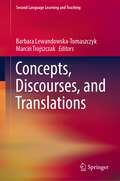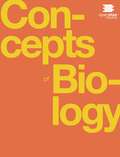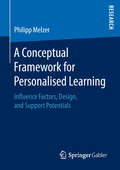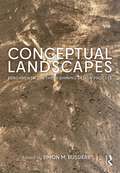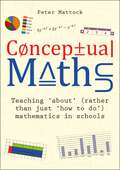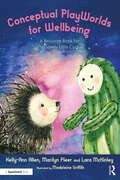- Table View
- List View
The Concepts and Practices of Lifelong Learning
by Michael Osborne Brenda Morgan-KleinThis textbook gives a wide-ranging, research-informed introduction to issues in lifelong learning across a variety of educational settings and practices. Its very accessible approach is multi-disciplinary drawing on sociology and psychology in particular. In addition, issues are discussed within an international context. While there has been a proliferation of texts focussing on particular areas of practice such as higher education, there is little in the way of a broad overview. Chapters one to four introduce various conceptions of lifelong learning, the factors that impinge on learning through the life course, and the social and the economic rationale for lifelong learning. Chapters five-ten consider the varied sites of lifelong learning, from the micro to macro (from the home to the region to the virtual). Chapter eleven draws the strands together in the context of turbulence and continuing transition in personal and work roles, and against the background of future technological development. This timely overview will be relevant to education and training professionals, education studies students and the general reader.
Concepts and Practices of STEM Education in Asia
by May May Hung Cheng Cathy Buntting Alister JonesThe purpose of this edited book is to enrich the literature related to STEM education at kindergarten, primary and secondary levels in Asia, with particular attention given to the analysis of the educational context in a number of Asian countries, including STEM-related policies, pedagogical practices, and the design and evaluation of STEM programmes. The discussions look into impacts on student learning outcomes and the ways in which STEM education is catering for schools and students’ interests and needs. The contributors are experts in STEM education or are leading major research and development projects in STEM in their regions. The book’s first section is focused at the macro-level on the conceptualization and formulation of STEM education policies in different regions, contributing to our understanding of the current status of STEM education in Asia. The second section examines some features of STEM learning and teaching at the classroom level and includes studies on student learning in STEM programmes. Pedagogical innovations implemented in different parts of Asia are also reported and discussed. The third section moves to teacher education and teacher professional development. It discusses practices of teacher professional development in the region and reports on current provisions as well as challenges. Together, the contributions from different Asian regions invite researchers and educators to learn from effective STEM practices, and point out areas for further development.Chapters "An Overview of STEM Education in Asia" and "STEM Teacher Professional Development for Primary School Teachers in Hong Kong" are available open access under a CC BY 4.0 license at link.springer.com.
Concepts, Discourses, and Translations (Second Language Learning and Teaching)
by Barbara Lewandowska-Tomaszczyk Marcin TrojszczakThis present book discusses issues related to languages, cultures, and discourses by addressing a variety of topics ranging from culture and translation, cognitive and linguistic dimensions of discourse, and the role of language in political discourses and bilingualism. By focusing on multiple interconnected research subjects, the book allows us to see the intersections of language, culture, and discourse in their full diversity and to illuminate their less frequented nooks and crannies in a timely fashion.
Concepts linked to my early independence (CFVI Resource)
by Guide DogsActivity Card focusing on 'Concepts linked to my early independence'. CFVI Area 5. Habilitation: Orientation and Mobility. Resource Type: Activity cards for parents and professionals.
Concepts of Biology
by OpenStaxConcepts of Biology is intended for the introductory biology course for non-science majors taught at most two- and four-year colleges. The scope, sequence, and level of the program are designed to match typical course syllabi. This text includes interesting features that make connections between scientific concepts and the everyday world of students. Concepts of Biology conveys the major themes of biology, such as a foundation in evolution, and features a rich and engaging art program.
Concepts Of Genetics: Pearson New International Edition (PDF)
by William S. Klug Michael R. Cummings Charlotte A. Spencer Michael A. PalladinoConcepts of Genetics is known for its focus on teaching core concepts and problem solving. This best-selling text has been extensively updated, with coverage on emerging topics in genetics, and problem-solving support has been enhanced.
Concepts of Matter in Science Education (Innovations in Science Education and Technology #19)
by Georgios Tsaparlis and Hannah SevianBringing together a wide collection of ideas, reviews, analyses and new research on particulate and structural concepts of matter, Concepts of Matter in Science Education informs practice from pre-school through graduate school learning and teaching and aims to inspire progress in science education. The expert contributors offer a range of reviews and critical analyses of related literature and in-depth analysis of specific issues, as well as new research. Among the themes covered are learning progressions for teaching a particle model of matter, the mental models of both students and teachers of the particulate nature of matter, educational technology, chemical reactions and chemical phenomena, chemical structure and bonding, quantum chemistry and the history and philosophy of science relating to the particulate nature of matter. The book will benefit a wide audience including classroom practitioners and student teachers at every educational level, teacher educators and researchers in science education. "If gaining the precise meaning in particulate terms of what is solid, what is liquid, and that air is a gas, were that simple, we would not be confronted with another book which, while suggesting new approaches to teaching these topics, confirms they are still very difficult for students to learn". Peter Fensham, Emeritus Professor Monash University, Adjunct Professor QUT (from the foreword to this book)
Concepts, Strategies and Models to Enhance Physics Teaching and Learning
by Eilish McLoughlin Paul Van KampenThis book discusses novel research on and practices in the field of physics teaching and learning. It gathers selected high-quality studies that were presented at the GIREP-ICPE-EPEC 2017 conference, which was jointly organised by the International Research Group on Physics Teaching (GIREP); European Physical Society – Physics Education Division, and the Physics Education Commission of the International Union of Pure and Applied Physics (IUPAP). The respective chapters address a wide variety of topics and approaches, pursued in various contexts and settings, all of which represent valuable contributions to the field of physics education research. Examples include the design of curricula and strategies to develop student competencies—including knowledge, skills, attitudes and values; workshop approaches to teacher education; and pedagogical strategies used to engage and motivate students. This book shares essential insights into current research on physics education and will be of interest to physics teachers, teacher educators and physics education researchers around the world who are working to combine research and practice in physics teaching and learning.
Conceptual and Procedural Knowledge: The Case of Mathematics
by James HiebertFirst Published in 1986. Routledge is an imprint of Taylor & Francis, an informa company.
Conceptual and Procedural Knowledge: The Case of Mathematics
by James HiebertFirst Published in 1986. Routledge is an imprint of Taylor & Francis, an informa company.
The Conceptual Coherence of the Book of Micah (The Library of Hebrew Bible/Old Testament Studies)
by Mignon R. JacobsThis book examines the coherence of the book of Micah by means of analysis of the text's literary structure and conceptuality. A two-part structure is proposed, divided between chs. 1-5 and 6-7, each part characterized by a dispute over the fate of Israel. The interrelationship of the parts, including prophecies of judgment and announcements of promise suggests that the basis of the book's coherence is that Yahweh's justice in judgment and mercy, preserving and forgiving the remnant, are the significant factors in determining Israel's fate.
A Conceptual Framework for Personalised Learning: Influence Factors, Design, and Support Potentials
by Philipp MelzerPhilipp Melzer analyses influence factors of personalised learning aiming to lay out design principles for personalised blended learning courses. Finding only weak support for a matching between learning styles and teaching methods,he defines learning tasks as the object of further investigations. Following the idea of a community of inquiry, the author develops the Personalised Learning Framework (PLF), modelling personalised learning as a process of selection as well as usage of learning tasks and learning tools by the community of inquiry. To evaluate the PLF further, a traditional university course is transformed to a personalised flipped classroom course. He shows how personalised learning can be supported in concrete learning interventions using specific learning methods and technologies.
Conceptual Frameworks for Giftedness and Talent Development: Enduring Theories and Comprehensive Models in Gifted Education
by Tracy L. CrossConceptual Frameworks for Giftedness and Talent Development explores current and enduring theories and comprehensive models of giftedness and talent development. Each chapter:Includes a description of the model, theory, or framework.Shares the most important implications of each model, including underrepresentation and social justice issues.Includes discussion questions for use with students and professionals.The editors also consider common issues across conceptual frameworks, such as the degree to which achievement defines giftedness, the goal of gifted education, and the role of psychosocial factors. This is a comprehensive reference for scholars and practitioners in the field, as well as those studying at the graduate level.
Conceptual Frameworks for Giftedness and Talent Development: Enduring Theories and Comprehensive Models in Gifted Education
by Tracy L. Cross Paula Olszewski-KubiliusConceptual Frameworks for Giftedness and Talent Development explores current and enduring theories and comprehensive models of giftedness and talent development. Each chapter:Includes a description of the model, theory, or framework.Shares the most important implications of each model, including underrepresentation and social justice issues.Includes discussion questions for use with students and professionals.The editors also consider common issues across conceptual frameworks, such as the degree to which achievement defines giftedness, the goal of gifted education, and the role of psychosocial factors. This is a comprehensive reference for scholars and practitioners in the field, as well as those studying at the graduate level.
Conceptual Landscapes: Fundamentals in the Beginning Design Process
by Simon M. BussiereConceptual Landscapes explores the dilemma faced in the early moments of design thinking through a gradient of work in landscape and environmental design media by both emerging and well-established designers and educators of landscape architecture. It questions where and, more importantly, how the process of design starts. The book deconstructs the steps of conceptualizing design in order to reignite pedagogical discussions about timing and design fundamentals, and to reveal how the spark of an idea happens – from a range of unique perspectives. Through a careful arrangement of visual essays that integrate analog, digital, and mixed-media works and processes, the book highlights differences between diverse techniques and triggers debate between design, representation, technology, and creative culture in the field. Taken together, the book’s visual investigation of the conceptual design process serves as a learning tool for aspiring designers and seasoned professionals alike. By situating student work alongside that of experienced teachers and landscape architects, the book also demystifies outdated notions of individual genius and sheds new light on the nearly universally messy process of discovery, bridged across years and diverse creative vocabularies in the conceptual design process. Lavishly illustrated with over 210 full color images, this book is a must-read for students and instructors in landscape architecture.
Conceptual Landscapes: Fundamentals in the Beginning Design Process
Conceptual Landscapes explores the dilemma faced in the early moments of design thinking through a gradient of work in landscape and environmental design media by both emerging and well-established designers and educators of landscape architecture. It questions where and, more importantly, how the process of design starts. The book deconstructs the steps of conceptualizing design in order to reignite pedagogical discussions about timing and design fundamentals, and to reveal how the spark of an idea happens – from a range of unique perspectives. Through a careful arrangement of visual essays that integrate analog, digital, and mixed-media works and processes, the book highlights differences between diverse techniques and triggers debate between design, representation, technology, and creative culture in the field. Taken together, the book’s visual investigation of the conceptual design process serves as a learning tool for aspiring designers and seasoned professionals alike. By situating student work alongside that of experienced teachers and landscape architects, the book also demystifies outdated notions of individual genius and sheds new light on the nearly universally messy process of discovery, bridged across years and diverse creative vocabularies in the conceptual design process. Lavishly illustrated with over 210 full color images, this book is a must-read for students and instructors in landscape architecture.
Conceptual Maths: Teaching 'about' (rather than just 'how to do') mathematics in schools
by Peter MattockWritten by Peter Mattock, Conceptual Maths: Teaching 'about' (rather than just 'how to do') mathematics in schoolsaims to empower teachers to support students on a comprehensive and coherent journey through school mathematics. Showcasing the best models, metaphors and representations, it provides excellent examples, explanations and exercises that can be used across the curriculum. Concepts are at the heart of the study of mathematics. They are the ideas that remain constant whenever they are encountered, but which combine and build upon each other to create the mathematical universe. It is the structure of each concept that gives rise to the procedures that are used in calculation and problem-solving - and, by learning about these structures, a learner can make sense of how different processes work and use them flexibly as need demands. In his first book,Visible Maths, Peter Mattock focused on the use of representations and manipulatives as images and tools and how this can provide a window into some of these mathematical structures. His aim in Conceptual Mathsis to go deeper, beyond the procedures, and to shed greater light on the structures of the subject's different concepts. The book explores how a variety of visual tools and techniques can be used in the classroom to deepen pupils' understanding of mathematical structures, concepts and operations, including: number; addition and subtraction; multiplication and multiples; division and factors; proportionality; functionality; measures; accuracy; probability; shape and transformation; and vectors, among many others. In so doing, Peter equips teachers with the confidence and practical know-how to help learners assimilate knowledge of mathematical concepts into their schema and take their learning to the next level. Containing numerous full-colour diagrams and models to illustrate the conceptual takeaways and teaching techniques discussed, Conceptual Mathsalso includes a glossary covering the key mathematical terms. Suitable for teachers of maths in primary, secondary and post-16 settings
Conceptual metaphor and embodied cognition in science learning
by Tamer G. Amin Fredrik Jeppsson Jesper HaglundScientific concepts are abstract human constructions, invented to make sense of complex natural phenomena. Scientists use specialised languages, diagrams, and mathematical representations of various kinds to convey these abstract constructions. This book uses the perspectives of embodied cognition and conceptual metaphor to explore how learners make sense of these concepts. That is, it is assumed that human cognition – including scientific cognition – is grounded in the body and in the material and social contexts in which it is embedded. Understanding abstract concepts is therefore grounded, via metaphor, in knowledge derived from sensory and motor experiences arising from interaction with the physical world. The volume consists of nine chapters that examine a number of intertwined themes: how systematic metaphorical mappings are implicit in scientific language, diagrams, mathematical representations, and the gestures used by scientists; how scientific modelling relies fundamentally on metaphor and can be seen as a form of narrative cognition; how implicit metaphors can be the sources of learner misconceptions; how conceptual change and the acquisition of scientific expertise involve learning to coordinate the use of multiple implicit metaphors; and how effective instruction can build on recognising the embodied nature of scientific cognition and the role of metaphor in scientific thought and learning. The volume also includes three extended commentaries from leading researchers in the fields of cognitive linguistics, the learning sciences, and science education, in which they reflect on theoretical, methodological and pedagogical issues raised in the book. This book was originally published as a special issue of the International Journal of Science Education.
Conceptual metaphor and embodied cognition in science learning
by Tamer G. Amin, Fredrik Jeppsson and Jesper HaglundScientific concepts are abstract human constructions, invented to make sense of complex natural phenomena. Scientists use specialised languages, diagrams, and mathematical representations of various kinds to convey these abstract constructions. This book uses the perspectives of embodied cognition and conceptual metaphor to explore how learners make sense of these concepts. That is, it is assumed that human cognition – including scientific cognition – is grounded in the body and in the material and social contexts in which it is embedded. Understanding abstract concepts is therefore grounded, via metaphor, in knowledge derived from sensory and motor experiences arising from interaction with the physical world. The volume consists of nine chapters that examine a number of intertwined themes: how systematic metaphorical mappings are implicit in scientific language, diagrams, mathematical representations, and the gestures used by scientists; how scientific modelling relies fundamentally on metaphor and can be seen as a form of narrative cognition; how implicit metaphors can be the sources of learner misconceptions; how conceptual change and the acquisition of scientific expertise involve learning to coordinate the use of multiple implicit metaphors; and how effective instruction can build on recognising the embodied nature of scientific cognition and the role of metaphor in scientific thought and learning. The volume also includes three extended commentaries from leading researchers in the fields of cognitive linguistics, the learning sciences, and science education, in which they reflect on theoretical, methodological and pedagogical issues raised in the book. This book was originally published as a special issue of the International Journal of Science Education.
Conceptual Model-Based Problem Solving: Teach Students with Learning Difficulties to Solve Math Problems
by Yan Ping XinAre you having trouble in finding Tier II intervention materials for elementary students who are struggling in math? Are you hungry for effective instructional strategies that will address students’ conceptual gap in additive and multiplicative math problem solving? Are you searching for a powerful and generalizable problem solving approach that will help those who are left behind in meeting the Common Core State Standards for Mathematics (CCSSM)? If so, this book is the answer for you. • The conceptual model-based problem solving (COMPS) program emphasizes mathematical modeling and algebraic representation of mathematical relations in equations, which are in line with the new Common Core. • “Through building most fundamental concepts pertinent to additive and multiplicative reasoning and making the connection between concrete and abstract modeling, students were prepared to go above and beyond concrete level of operation and be able to use mathematical models to solve more complex real-world problems. As the connection is made between the concrete model (or students’ existing knowledge scheme) and the symbolic mathematical algorithm, the abstract mathematical models are no longer “alien” to the students.” As Ms. Karen Combs, Director of Elementary Education of Lafayette School Corporation in Indiana, testified: “It really worked with our kids!” • “One hallmark of mathematical understanding is the ability to justify,… why a particular mathematical statement is true or where a mathematical rule comes from” (http://illustrativemathematics.org/standards). Through making connections between mathematical ideas, the COMPS program makes explicit the reasoning behind math, which has the potential to promote a powerful transfer of knowledge by applying the learned conception to solve other problems in new contexts. • Dr. Yan Ping Xin’s book contains essential tools for teachers to help students with learning disabilities or difficulties close the gap in mathematics word problem solving. I have witnessed many struggling students use these strategies to solve word problems and gain confidence as learners of mathematics. This book is a valuable resource for general and special education teachers of mathematics. - Casey Hord, PhD, University of Cincinnati
Conceptual PlayWorlds for Wellbeing: A Resource Book for the Lonely Little Cactus (Building Belonging and PlayWorlds for Wellbeing)
by Kelly-Ann Allen Marilyn Fleer Lara McKinleyFor effective use, this book should be purchased alongside the story book, The Lonely Little Cactus: A Story About Friendship, Coping, and Belonging. Both books can be purchased together as a set, Building Conceptual PlayWorlds for Wellbeing: The Lonely Little Cactus Story Book and Accompanying Resource Book. This vital resource uses the evidence-driven Conceptual PlayWorlds model of intentional teaching developed by Professor Marilyn Fleer to provide supporting classroom- or home-based activities to help children aged between 4 and 8 solve challenges and learn wellbeing concepts through play. Intended for use with the accompanying picture story book, The Lonely Little Cactus, a tale about a cactus that feels lonely living in the desert, this guide offers imagery-rich scenarios, including 20 unique activities so children have an opportunity to experientially grasp wellbeing concepts that can be otherwise difficult to explain. This resource guides educators through a range of wellbeing activities including: Identifying feelings Coping (social support, problem solving, and self-regulation) Friendships (relationship building, working together, time with friends, social skills) Positive emotions (happiness, joy, doing something you love, enjoyment, fun) Relaxation strategies Belonging and inclusion (working together, collaboration, joining in play, including others). Offering a unique opportunity for children to learn about psychological strategies while being engaged in a beautiful narrative and visually captivating illustrations, this is the ideal resource for educators, support staff, practitioners and parents looking to help children understand and manage their feelings.
Conceptual PlayWorlds for Wellbeing: A Resource Book for the Lonely Little Cactus (Building Belonging and PlayWorlds for Wellbeing)
by Kelly-Ann Allen Marilyn Fleer Lara McKinleyFor effective use, this book should be purchased alongside the story book, The Lonely Little Cactus: A Story About Friendship, Coping, and Belonging. Both books can be purchased together as a set, Building Conceptual PlayWorlds for Wellbeing: The Lonely Little Cactus Story Book and Accompanying Resource Book. This vital resource uses the evidence-driven Conceptual PlayWorlds model of intentional teaching developed by Professor Marilyn Fleer to provide supporting classroom- or home-based activities to help children aged between 4 and 8 solve challenges and learn wellbeing concepts through play. Intended for use with the accompanying picture story book, The Lonely Little Cactus, a tale about a cactus that feels lonely living in the desert, this guide offers imagery-rich scenarios, including 20 unique activities so children have an opportunity to experientially grasp wellbeing concepts that can be otherwise difficult to explain. This resource guides educators through a range of wellbeing activities including: Identifying feelings Coping (social support, problem solving, and self-regulation) Friendships (relationship building, working together, time with friends, social skills) Positive emotions (happiness, joy, doing something you love, enjoyment, fun) Relaxation strategies Belonging and inclusion (working together, collaboration, joining in play, including others). Offering a unique opportunity for children to learn about psychological strategies while being engaged in a beautiful narrative and visually captivating illustrations, this is the ideal resource for educators, support staff, practitioners and parents looking to help children understand and manage their feelings.
Conceptual Profiles: A Theory of Teaching and Learning Scientific Concepts (Contemporary Trends and Issues in Science Education #42)
by Eduardo F. Mortimer Charbel N. El-HaniThe language of science has many words and phrases whose meaning either changes in differing contexts or alters to reflect developments in a given discipline. This book presents the authors’ theories on using ‘conceptual profiles’ to make the teaching of context-dependent meanings more effective. Developed over two decades, their theory begins with a recognition of the coexistence in the students’ discourse of those alternative meanings, even in the case of scientific concepts such as molecule, where the dissonance between the classical and modern views of the same phenomenon is an accepted norm. What began as an alternative model of conceptual change has evolved to incorporate a sociocultural approach, by drawing on ideas such as situated cognition and Vygotsky’s influential concept of culturally located learning. Also informed by pragmatist philosophy, the approach has grown into a well-rounded theory of teaching and learning scientific concepts. The authors have taken the opportunity in this book to develop their ideas further, anticipate and respond to criticisms—that of relativism, for example—and explain how their theory can be applied to analyze the teaching of core concepts in science such as heat and temperature, life and biological adaptation. They also report on the implementation of a research program that correlates the responsiveness of their methodology to all the main developments in the field of science education. This additional material will inform academic discussion, review, and further enhancement of their theory and research model.
Conceptual Shifts and Contextualized Practices in Education for Glocal Interaction: Issues and Implications (Intercultural Communication and Language Education)
by Ali Fuad Selvi Nathanael RudolphThis book employs the realm of English Language Teaching (ELT) as a discursive point of departure to explore how individuals, groups, entities and institutions apprehend, embrace, deal with, manipulate, problematize and resist glocal flows of people, ideas, information, goods, and technology. It apprehends and attends to tensions arising from the fluidly local-global construction and negotiation of borders of identity and interaction within a diverse array of contexts and English education therein. These tensions, whether conceptual or pedagogical, may arise in and through governmental and institutional policymaking, teacher training, or curriculum and materials development, and in the learning experience both within and beyond the classroom, as teachers and students engage with course content and each other.
Conceptualising Child-Adult Relations
by Leena Alanen Berry MayallConceptualising Child-Adult Relations focuses on how children conceptualise and experience child-adult relations. The authors explore the idea of generation as a key to understanding children's agency in intersection with social worlds which are largely organised and ordered by adults. The authors explore two interconnected themes: how children define the division of labour between children and adults, and how far children regard themselves as constituting a seperate group. This book is ground-breaking in its focus on the variety and commonality in children's lives and views across a broad range of contexts. It provides innovative theoretical approaches to the growing study of childhood by homing in on intergenerational relations as a main concept, and draws attention to links across the main sites of children's lives such as the home, neighbourhood and school. Moreover, for policy related issues, this book provides food for thought about the social conditions and status of childhood, and the factors structuring it.


